Laboratories within CDMOs are fast-paced environments dealing with multiple customer products with unique requirements. Flexibility and reliability are, therefore, critical considerations when selecting a mechanical testing system. The machine must:
- Be compatible with multiple testing methods and processes to meet each customer's requirements; and
- Ensure the samples meet dose accuracy requirements to ISO 11608-1 and any other internal standards.
Variations due to operator error will immediately cause production to stop, leading to long delays due to troubleshooting.
Given the challenges, switching to an automated system that maximizes flexibility and minimizes the risk of human errors seems intuitive. But not all automated solutions are created equal, and there isn't a one-size-fits-all approach. With this in mind, the key factors to consider before selecting an automated system include:
- Expected testing volume;
- Testing frequency;
- Changeover frequency;
- Level of production integration;
- Data collection and storage;
- Specimen/sample information; and
- Physical space constraints.
Once you’ve assessed all your lab’s needs, you should consider which automation system meets those needs. Automated solutions range from simple two-axis stages to advanced six-axis robots. However, cobot-based systems are usually the best fit for CDMO lab environments.
For example, Instron's CT6 cobot test system is easy to program and can adapt to test different product specimens effortlessly. All you have to do is make a few simple modifications to the load/unload sequence. Accessories are another important consideration. For example, a pneumatic load controllable gripper on the cobot is ideal for handling a wide range of AD devices. This feature ensures that every specimen, irrespective of its geometry, is handled consistently during testing, minimizing the risk of variations.

Now that you have selected your cobot-based testing system, it’s time to focus on the setup process. First, think location. How is the layout of the lab space? How are samples going to be loaded into the system? For example, if testing is fully integrated into the manufacturing workflow, the cobot may need to be near the production line.
The loading procedure is another important consideration. Advanced cobot systems such as the CT6 enable you to tailor the grips and specimen trays to multiple AD devices. You can even customize the system to work with device trays straight from the production line to minimize setup time. All you have to do is provide the supplier with the correct tray dimensions so that they can ensure there are features to center it in the workspace.
The latest mechanical testing automation technology provides plenty of insightful data. Using this data effectively is key to improving efficiency, throughput, and repeatability over time. Here are some top tips on how to make the most of your data
- Utilize barcoding – This way you can automatically enter relevant data, helping expedite the entry process and minimize errors;
- Opt for pass/fail criteria – This feature allows you to easily control alternate workflows to separate defective parts from the rest of the batch; and
- Leverage Bluehill Central – This software developed by Instron ensures all client data is siloed appropriately, creating distinct groups to store methods, samples, and test reports.

One of the advantages of using automation in AD device testing is that cobots require little maintenance. In a typical syringe testing application, specimens tend to be much lighter than a cobot’s capacity, meaning you’re not putting a much of any strain on the system. For example, some of the smaller capacity cobots on the market have a 3kg capacity, while most AD devices weigh less than 250g.
However, some maintenance operations are essential to limit downtime and increase the system’s lifespan. Firstly, daily cleaning of the fingers and racking is necessary to ensure proper function. Dust and dirt may build up on the gripper fingers, making handling specimens more difficult and increasing the risk of mishandling. Rubber fingers can cause specimens to stick and may require more frequent cleaning.
Another important maintenance routine is the monthly inspection of all cabling, ventilation, and airflow to verify the condition.
You should also assess the tightness of screws and bolts at least monthly. The repeated motion of automation systems can cause screws and bolts to loosen over time - even those equipped with thread lockers.
Mechanical testing automation is here to stay, and cobot-based systems are a flexible and efficient solution to many challenges faced by testing labs within CDMOs. As the demand for AD syringes continues to grow, a cobot-based system can help your lab deal with more customer requests more efficiently, maximizing test accuracy and throughput.
To learn more about Instron’s cobot-based solutions for biomedical manufacturing applications visit the CT6 Cobot Testing Systems page.
